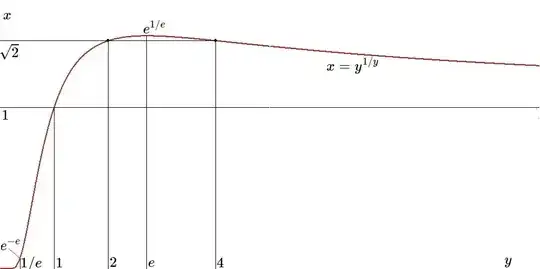If you want to solve for $$\large{x^{x^{.^{.^{.^.}}}}=2}$$ With an infinite tower of $x$
You say that there is a copy on top and say $x^2$=2 and then solve to get $x$=${\pm}{\sqrt{2}}$ .
but if you solve for : (using same technique )$$\large{x^{x^{.^{.^{.^.}}}}=4}$$
you again get $x$=${\pm}{\sqrt{2}}$ ( this can of course can not be true )
And so there is a theorem that states
If :$$\large{e^{-e} {\le}x{\le}} e^{1/e}$$ and $$\large{{1/e}{\le}y{\le} e}$$ for $x$ being the value that is infinitely exponentiated and y being a value that it converges to.
then
the infinite tower will converge to y
Since for the four case y>e it does not converge to 4 .And since the two case satisfies the inequalities it converges to 2
Q: I want to know how to rigorously derive these bounds
Asked
Active
Viewed 145 times
0
Vivaan Daga
- 5,531
-
1I think this has been asked here already, I guess soon someone will post a link to a duplicate. – Peter Jun 17 '20 at 18:28
-
See: https://math.stackexchange.com/questions/890319/convergence-of-tetration-sequence/890911#890911 – Jun 17 '20 at 19:50
-
Does this answer your question? Convergence of tetration sequence. – Mark S. Jun 18 '20 at 12:50
-
@YiannisGalidakis what about bounds for y? – Vivaan Daga Jun 18 '20 at 13:12
-
1@MarkS. what about bounds for y? – Vivaan Daga Jun 18 '20 at 13:19
-
Minimum is verified at here, but I couldn't quickly find a post verifying the maximum. – Mark S. Jun 18 '20 at 13:27
1 Answers
1
The OP says: this of course can not be true.
But that's only for the power tower as such.
What seems to have been considered instead, however, is the inverse function of the tower:
$$
y = x^{x^{.^{.^{.^.}}}} = x^y \quad \Longrightarrow \quad x = y^{1/y}
$$
Scaling in $y$-direction is three times scaling in $x$-direction in the picture below, for good reasons.

While the power tower itself is not defined outside the interval $e^{-e} \le x \le e^{1/e}$, the inverse function, when considered apart from the former, is defined, not only for $\,1/e \le y \le e\,$ but for a much larger domain, namely $\,0 \le y \lt \infty\,$. Details of function behaviour are described a great deal in the following MSE posting and its references:
It's easy to prove that $\,\lim_{y\to\infty} y^{1/y} = 1\,$. This means that $\,x = y^{1/y}\,$ has twofold solutions $\,y_{1,2}\,$ for $\,1 \lt x \lt e^{1/e}\,$, one $\,1 \lt y_1 \lt e\,$ and the other $\,e \lt y_2\,$, wich is anyway clear from the picture. Indeed the OP's solutions are among these: $\,1 \lt 2\lt e \lt 4\,$.Numerically. Solutions of $\,y^{1/y}=x\,$ have been calculated by the (Delphi Pascal) program below. Values of $\,x\,$ are taken from a sample array, giving accompanying $\,y_{1,2}\,$ values with Newton's method. Initial $\,y_{1,2}\,$ are taken from previous steps, starting with the two known values from the question.
program edit;Output:
function Newton(y12,x : double) : double; const eps : double = 1.e-9; var y : double; begin y := y12; while abs(exp(ln(y)/y)-x) > eps do y := y - (exp(ln(y)/y)-x) * sqr(y)/(exp(ln(y)/y)*(1-ln(y))); Newton := y; end;
procedure test; const x : array[0..8] of double = (1.4, 1.3, 1.2, 1.1, 1.05, 1.02, 1.01, 1.001, 1.0001); var y1,y2 : double; k : integer; begin y1 := 2; y2 := 4; for k := 0 to 8 do begin y1 := Newton(y1,x[k]); y2 := Newton(y2,x[k]); Writeln(x[k],' ==> (',y1,',',y2,')'); end; end;
begin test; end.
1.40000000000000E+0000 ==> ( 1.88666330624630E+0000, 4.41029279309327E+0000) 1.30000000000000E+0000 ==> ( 1.47098895928257E+0000, 7.85706535100170E+0000) 1.20000000000000E+0000 ==> ( 1.25773454121357E+0000, 1.47674583809828E+0001) 1.10000000000000E+0000 ==> ( 1.11178201104165E+0000, 3.82287327653121E+0001) 1.05000000000000E+0000 ==> ( 1.05270345488064E+0000, 9.28715283791938E+0001) 1.02000000000000E+0000 ==> ( 1.02041238660200E+0000, 2.85536314597273E+0002) 1.01000000000000E+0000 ==> ( 1.01010152374054E+0000, 6.51100334614211E+0002) 1.00100000000000E+0000 ==> ( 1.00100100150234E+0000, 9.12312634995737E+0003) 1.00010000000000E+0000 ==> ( 1.00010001000084E+0000, 1.16676997475209E+0005)It is seen that the $\,y_1\,$ values near $\,y=1\,$ are close to $\,x\,$. Which should not be surprising, because $1^{1/1}=1$ and $\,\left. dx/dy\right|_{y=1}=1\,$. But I have no decent estimate for the "far away" solutions $\,y_2\,$.
Han de Bruijn
- 17,070
-
By substituting $u=1/y$ the function $x=y^{1/y}$ is mapped onto $x=u^{-u}$. Which has a value $1$ for $u\to 0$ and a derivative $dx/du(u\to 0)\to\infty$. The latter is a measure for the error in the outcomes for $u\to 0;$ i.e. $y\to\infty$. This makes me think that there does not exist any decent approximation for the "far away" $y_2$ values. – Han de Bruijn Jul 01 '21 at 14:46